Body length: 4–5 mm.
Eyes: eye interommatidial setaeseta:
a sclerotized hair-like projection of the cuticle
absent, eye deeply emarginateemarginate:
notched at the margin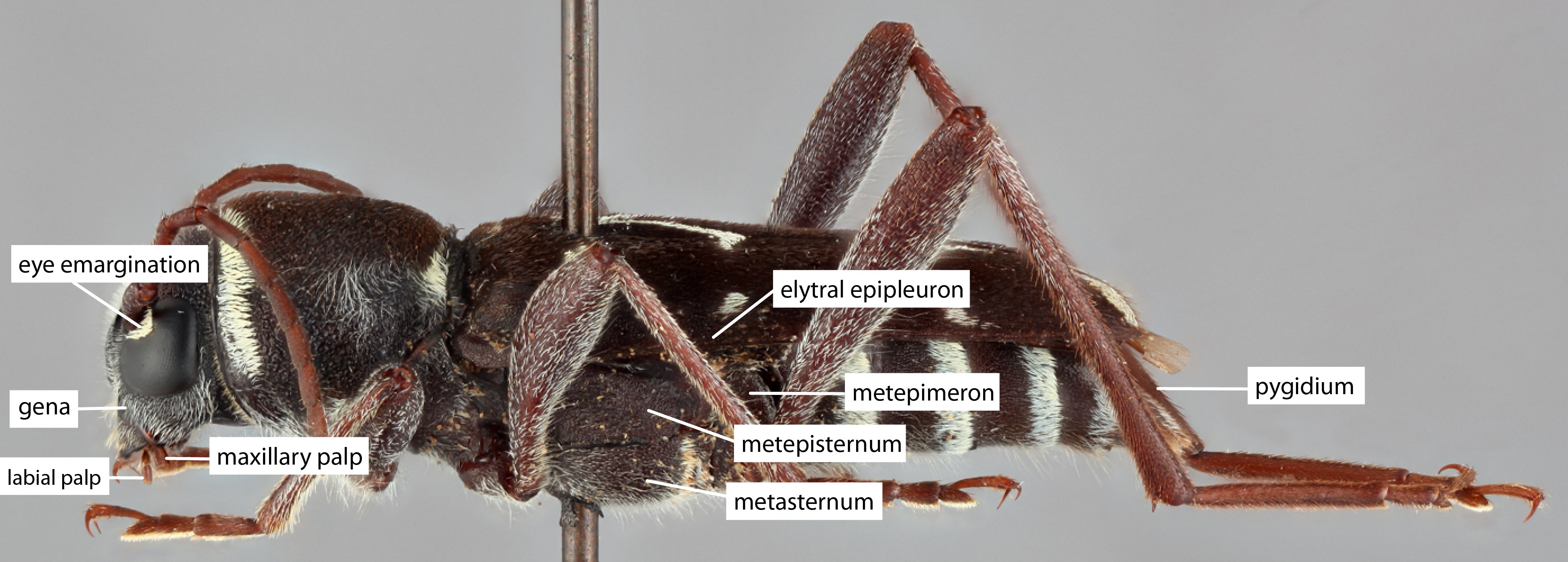 > half width, eye ommatidial density fine.
> half width, eye ommatidial density fine.
Antennaeantenna:
in larval and adult insects, paired segmented appendages, borne one on each side of the head, functioning as sense organs and bearing a large number of sensilla
: antennal length reaching/surpassing end of body, antennal flagellar segments elongateelongate:
much longer than wide
, scapescape:
the first proximal segment of the antenna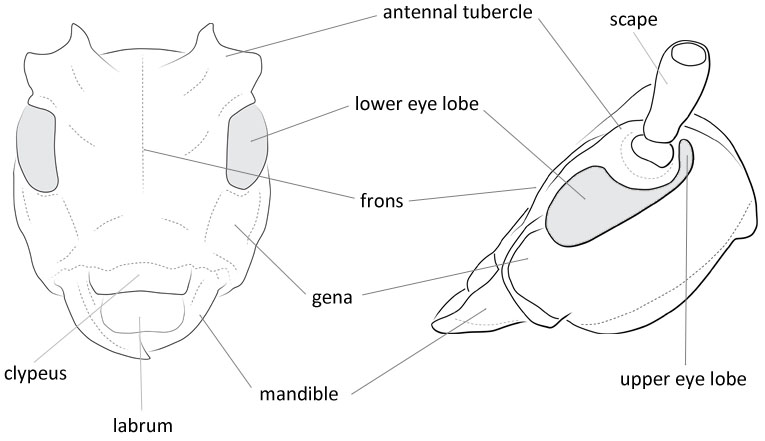 smooth/punctate at apexapex:
smooth/punctate at apexapex:
end of any structure distad to the base
, antennal scapescape:
the first proximal segment of the antenna ≥ segment 3, rarely segment 3 > scapescape:
≥ segment 3, rarely segment 3 > scapescape:
the first proximal segment of the antenna .
.
Pronotumpronotum:
the upper and dorsal part of the prothorax
: pronotumpronotum:
the upper and dorsal part of the prothorax
shape transversetransverse:
broader than long
, rarely subquadratesubquadrate:
not quite a square
, pronotumpronotum:
the upper and dorsal part of the prothorax
lateral armature acute spinespine:
a protuberance with an acute (sharp) distal end
.
Prosternum: prosternal processprosternal process:
a posterior extension of the prosternum between the coxae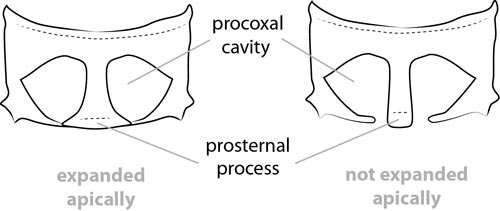 dilated at apexapex:
dilated at apexapex:
end of any structure distad to the base
, procoxal cavities closed posteriorly.
Elytraelytron:
the leathery forewing of beetles, serving as a covering for the hind wings, commonly meeting opposite elytron in a straight line down the middle of the dorsum in repose
: elytral length reaching or close to end of abdomen, elytral apicesapex:
end of any structure distad to the base
rounded or truncatetruncate:
cut off squarely at the tip
, elytral color pattern present.
Legs: visible tarsomerestarsomere:
subdivision or article of the tarsus, usually numbering from two to five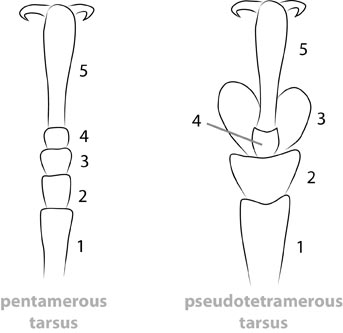 : 4, femora clavateclavate:
: 4, femora clavateclavate:
thickening gradually toward the tip
, protibial spursprotibial spur:
sclerotized spine(s) located at the distal tibia; can be single, double, or absent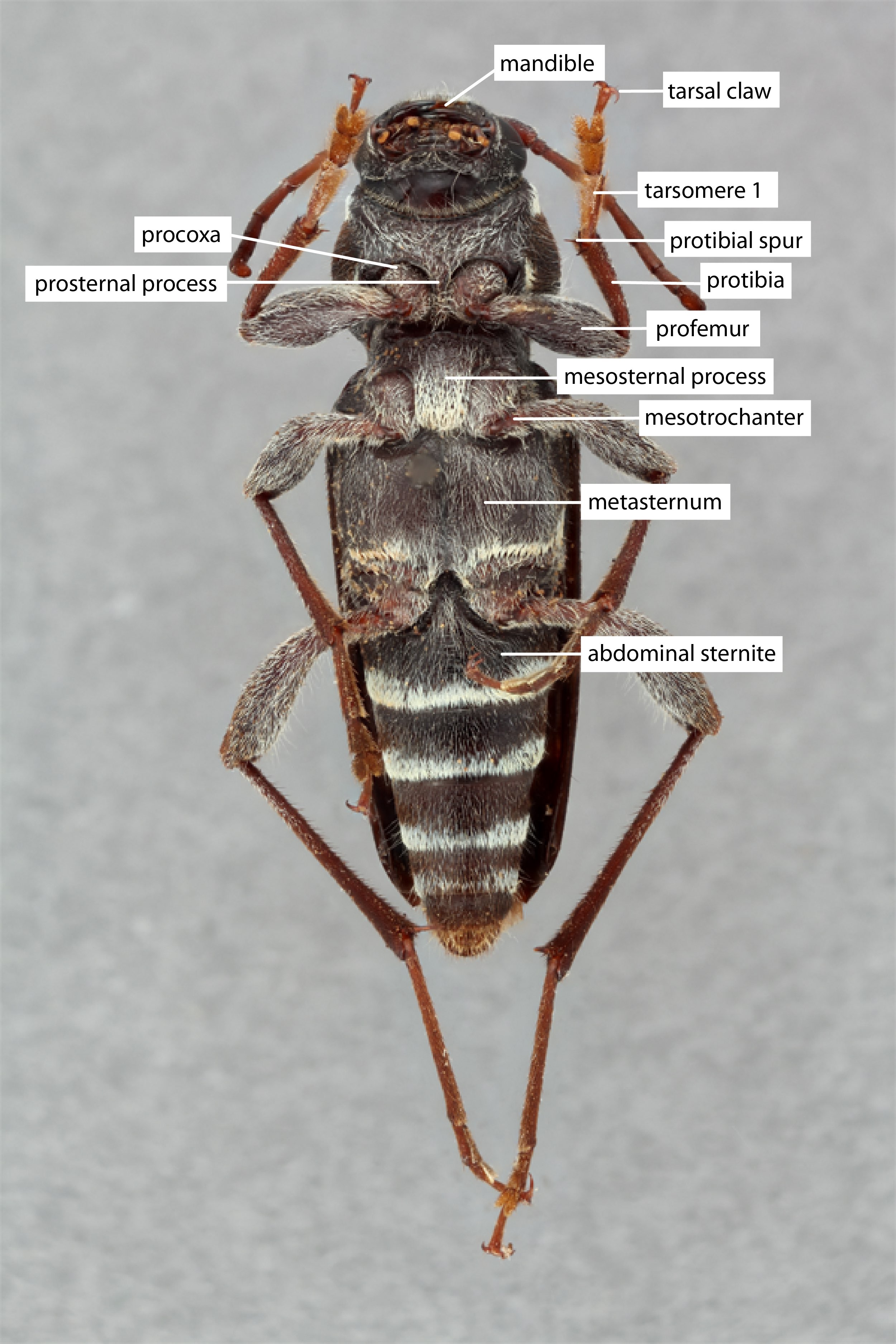 : 2, tarsal clawstarsal claw:
: 2, tarsal clawstarsal claw:
usually paired claws of the pretarsus, at the distal end of the leg with tooth/bump near claw basebase:
with tooth/bump near claw basebase:
the part of any appendage or structure that is nearest the body
.
Geographic region: Palearctic or Indomalaya.
Body small, usually cylindricalcylindrical:
shaped like a cylinder, parallel sided
, clothed with pubescence and scattered several suberect setaeseta:
a sclerotized hair-like projection of the cuticle
. Head voluminous; fronsfrons:
the upper anterior portion of the head capsule, usually a distinct sclerite between the epicranium and clypeus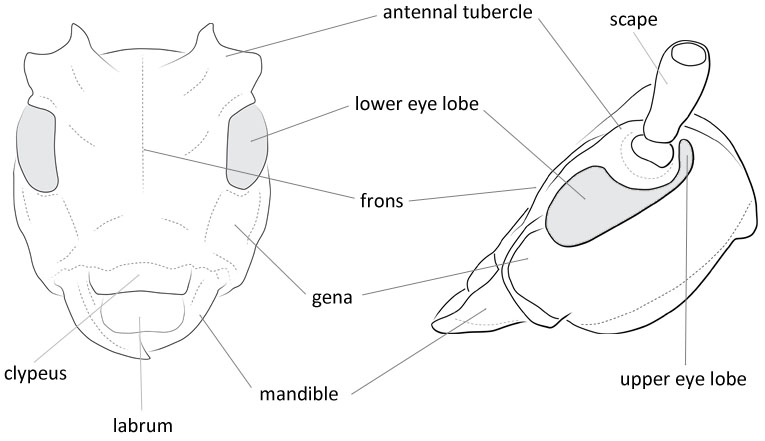 convex with genagena:
convex with genagena:
the part of the cranium on each side below the eye fully inflated; vertexvertex:
fully inflated; vertexvertex:
the top of the head between the eyes, frons and occiput, anterior to the occipital suture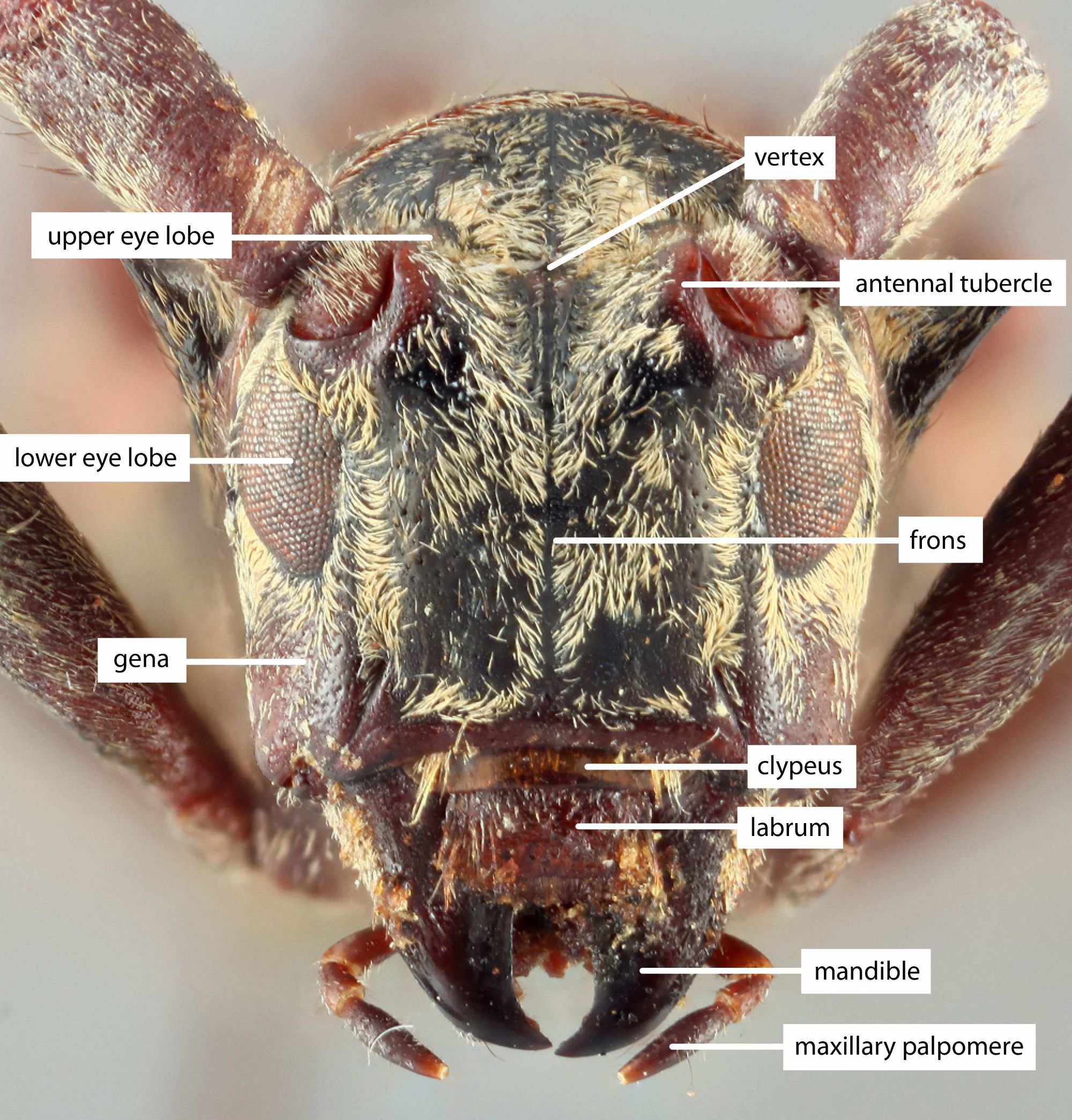 broad with inter-antennal area widely and shallowly concave; occiputocciput:
broad with inter-antennal area widely and shallowly concave; occiputocciput:
dorsal part of the head between the occipital sulcus and the postoccipital sulcus
convex and fully inflated; eyes large, deeply emarginateemarginate:
notched at the margin . Antennaeantenna:
. Antennaeantenna:
in larval and adult insects, paired segmented appendages, borne one on each side of the head, functioning as sense organs and bearing a large number of sensilla
stout, usually shorter than body length or the last segment reaching elytral apexapex:
end of any structure distad to the base
; scapescape:
the first proximal segment of the antenna strongly clavateclavate:
strongly clavateclavate:
thickening gradually toward the tip
with long erect hairs, almost same as long as third; third segment more or less shorter than fourth; underside of second to the last segment provided with long erect hairs. Pronotumpronotum:
the upper and dorsal part of the prothorax
longer than wide, each lateral side provided with a spinespine:
a protuberance with an acute (sharp) distal end
or a tubercletubercle:
a small knoblike or rounded protuberance
which is sometimes indistinct; disc gibbous with triangularly arranged three distinct or indistinct swellings; the area between swellings and lateral tubercles longitudinally rugoserugose:
wrinkled
. Prosternum with intercoxal process narrow, about 1/4 as wide as coxal cavities. Mesosternummesosternum:
sternum of the mesothorax
with intercoxal process almost plane, about 1/3 as wide as coxal cavities. Elytraelytron:
the leathery forewing of beetles, serving as a covering for the hind wings, commonly meeting opposite elytron in a straight line down the middle of the dorsum in repose
2.0–2.6 times as long as humeral width; disk provided with a pair of large callosities at basal area, and usually with several distinct or indistinct tubercles throughout; area just behind the callosities broadly and obliquely impressed; each elytronelytron:
the leathery forewing of beetles, serving as a covering for the hind wings, commonly meeting opposite elytron in a straight line down the middle of the dorsum in repose
with a costa extending from humerushumerus:
shoulder; the basal exterior angle of the elytra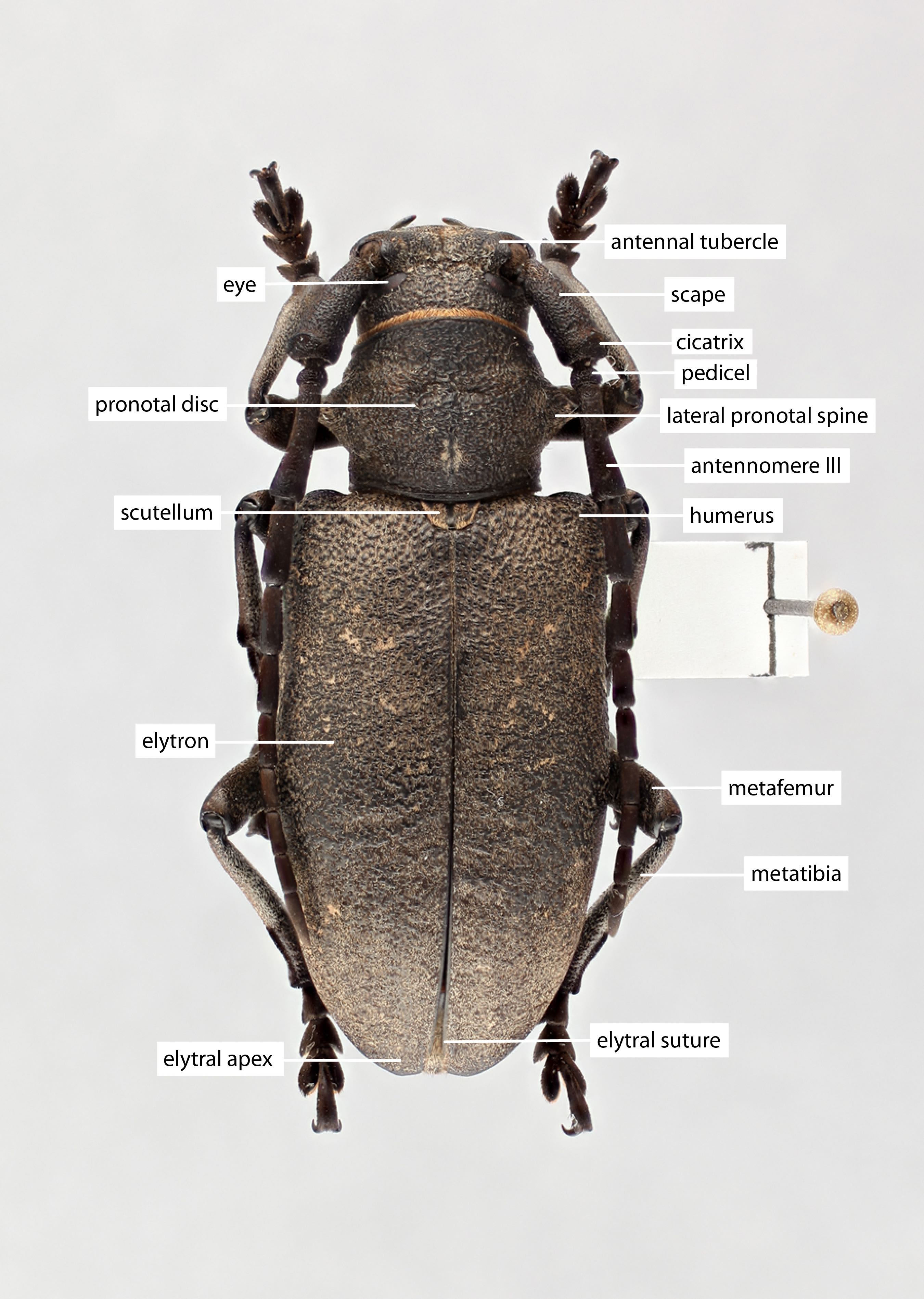 to apexapex:
to apexapex:
end of any structure distad to the base
. Legs short; femora clavateclavate:
thickening gradually toward the tip
; middle and hind tibiaetibia:
the leg segment distal to the femur, proximal to the tarsus
with a distinct external sinus at apical one-fourth; first segment of each tarsustarsus:
the leg segment distal to the apex of the tibia, bearing the pretarsus; consists of one to five tarsomeres (including pretarsus)
almost same as long as the following two segment combined; claws usually without distinct appendage (Hasegawa and Ohbayashi 2001Hasegawa and Ohbayashi 2001:
Hasegawa M and Ohbayashi N. 2001. A revisional study on the genus Miccolamia of Japan (Coleoptera, Cerambycidae, Lamiinae). The Japanese Journal of Systematic Entomology 7(1): 1–28, 84 figs.).
Can be distinguished from subgenus Miccolamia by the simple tarsal clawstarsal claw:
usually paired claws of the pretarsus, at the distal end of the leg . The inflated clavateclavate:
. The inflated clavateclavate:
thickening gradually toward the tip
scapescape:
the first proximal segment of the antenna , very small size, and rounded elytral apicesapex:
, very small size, and rounded elytral apicesapex:
end of any structure distad to the base
will distinguish from Pogonocherus.
Japan
broadleaf; Abies
6 spp. Conifers: M. (I.) glabricula.
Isomiccolamia Ohbayashi, 1963